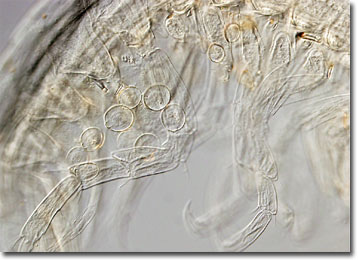Differential Interference Contrast Image Gallery
Amphipods (Grammarus)
Amphipods are small crustaceans that inhabit lakes, rivers, and seas, as well as beaches and caves. Diverse and abundant, the creatures are an important food source for many fishes, birds, and invertebrates and are sometimes used as indicators of water quality, especially in the Great Lakes of the United States.

Approximately 4,600 species of amphipods exist, but they are often known by other names. Amphipods that live in sandy beaches are frequently called sand hoppers or sand fleas, while those that thrive in freshwater habitats and marine beaches are commonly referred to as scuds. Yet, no matter what name they are known by, most amphipods are brightly colored and are similar in appearance to petite shrimp, generally ranging in size from four to ten millimeters. In the deep sea, however, some scavenger species of amphipods may obtain lengths of up to 140 millimeters.
Amphipods consist of two distinct sexes, males characteristically possessing enlarged claws on their second thoracic segment that are used to hold females during copulation. Fertilization of eggs is believed to take place externally, and clutch size may vary from one to several hundred eggs. Female amphipods carry fertilized eggs in a brood pouch and young amphipods may remain there for several days or weeks even after they hatch. Subsequent to multiple molts over a one to four month period, the crustaceans reach sexual maturity, enabling them to produce a new generation of amphipods.
